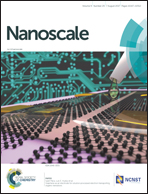Magnetic skyrmions without the skyrmion Hall effect in a magnetic nanotrack with perpendicular anisotropy†
Abstract
Magnetic skyrmions have potential applications in novel information devices with excellent energy efficiency. However, the skyrmion Hall effect (SkHE) could cause skyrmions moving in a nanotrack to get annihilated at the track edge. In this work, we discovered that the SkHE is depressed by modifying the magnetic structure at the edge of a track, and thus the skyrmion can move in almost a straight line at a high speed. Unlike the inner part of a track with perpendicular magnetic anisotropy, the edge layer exhibits in-plane magnetic anisotropy, and the orientation of edge moments is opposite that at the perimeter of skyrmions nearby. As a result, an enhanced repulsive force acts on the skyrmion to oppose the Magnus force that causes the SkHE. Additionally, the Dzyaloshinskii–Moriya interaction (DMI) constant of the edge layer also matters. When there is no DMI at the edge layer, the transverse displacement of the skyrmion can be depressed effectively when the width of the edge layer is sufficiently large. However, when the inner part and the edge share the same DMI constant, non-monotonically varied transverse displacement occurs because of the Néel-wall-like structure at the edge layer.



 Please wait while we load your content...
Please wait while we load your content...